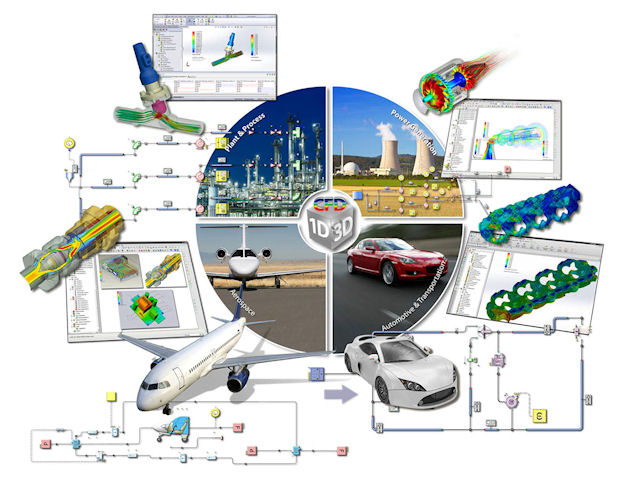What is System Level Thermo-Fluid Analysis?

Latest News
January 22, 2015
 Dear Desktop Engineering Reader:
Dear Desktop Engineering Reader:
Fluids are tricky things to work with, and simulating fluid networks can be trickier. You have all sorts of variables: Viscosity, pressure, temperatures, volumes and kinetic energies as well as an endless assortment of valves, pipes, pipe finishes and pumps, compressors and other geometries. These thermodynamic and modeling challenges are right up the alley of CFD (computational fluid dynamics) analysis.
The problem is that it is generally considered computationally impractical to take a system-level approach to a fluid network simulation with 3D CFD. This is why Navier-Stokes equations are the most commonly used approach. They let you investigate discrete, isolated 3D geometries with any effects of the surroundings reduced to idealized boundary conditions. They are effective and highly useful equations.
But Navier-Stokes is not a panacea. For example, when you are designing, say, a system for moving oil through a pipeline, you may not have decent 3D geometry to work with. Even if you have good 3D geometry, realistically simulating the system is computationally intense, often beyond the horsepower you have available.
So what’s a practical, useful and efficient method to handle the scale, fluid type and engineering application of a system-level fluid network simulation? Today’s Check it Out link takes you to a seven-page white paper that argues, convincingly, 1D system CFD simulation is up to the task. Only please do not call it that. Call it “system-level thermo-fluid analysis” instead.
“What is System Level Thermo-Fluid Analysis? An Introduction to the Unsung Hero of Fluid Simulation” demonstrates how system-level thermo-fluid simulations can handle fluid network systems in both steady state and transient conditions. The trick is that this methodology can capture three-dimensional loss data in a two-dimensional performance map.
That means important things for you. First and foremost, system-level thermo-fluid simulation enables you to capture the required loss information for a component without the computational overhead you have with an approach relying on 3D geometry. Second, without all that overhead, you can load up your analysis and investigations with more realistic information, such as accurate rheological data for the fluid you’re looking at, models of pressure drop and flow rates or pressure waves throughout a system.
This paper explains various fundamentals of a system-level thermo-fluid analysis approach. The topics it looks at will be familiar to anyone designing or operating fluid networks: two-phase and non-Newtonian fluids, pressure differentials, time and the affects of pipe orientation, pipe materials, fluid velocity and the rate of heat addition on fluid behavior.
Be assured that this paper does not come to trash talk 3D CFD. In fact, it implicitly advocates collaboration between the two approaches. For example, when discussing component interaction effects with non-standard combinations of components, it notes that 3D CFD can provide effective data to help enhance your thermo-fluid analyses.
A particular strength of the paper is that although Mentor Graphics produced it, there’s no mention whatsoever of the company’s Flowmaster general-purpose CFD solution for modeling and analyzing fluid mechanics and pipe/duct flow in complex systems. Kudos for a straight-shooting piece.
Kudos also go to the paper’s unattributed author(s). The writing is clear, concise and convincing. Its modest level of technical depth will engage engineers versed in fluid networks, yet it can easily provide your less technical colleagues with a working knowledge of the subject. The handful of images swell the scene appropriately, and the witty asides slipped in now and again were much appreciated.
If I had to add anything to this work, it would be links to a pair of brief, informative and amusing videos that Mentor produced on this subject called “What is System Level Thermo-Fluid Analysis?” So here they are: Watch Part One here and Part Two here.
In short, “What is System Level Thermo-Fluid Analysis? An Introduction to the Unsung Hero of Fluid Simulation” is a thoroughly good read. Hit today’s Check it Out link to download your complimentary copy.
Thanks, Pal. – Lockwood
Anthony J. Lockwood
Editor at Large, Desktop Engineering
Subscribe to our FREE magazine, FREE email newsletters or both!
Latest News
About the Author
Anthony J. Lockwood is Digital Engineering’s founding editor. He is now retired. Contact him via [email protected].
Follow DE






